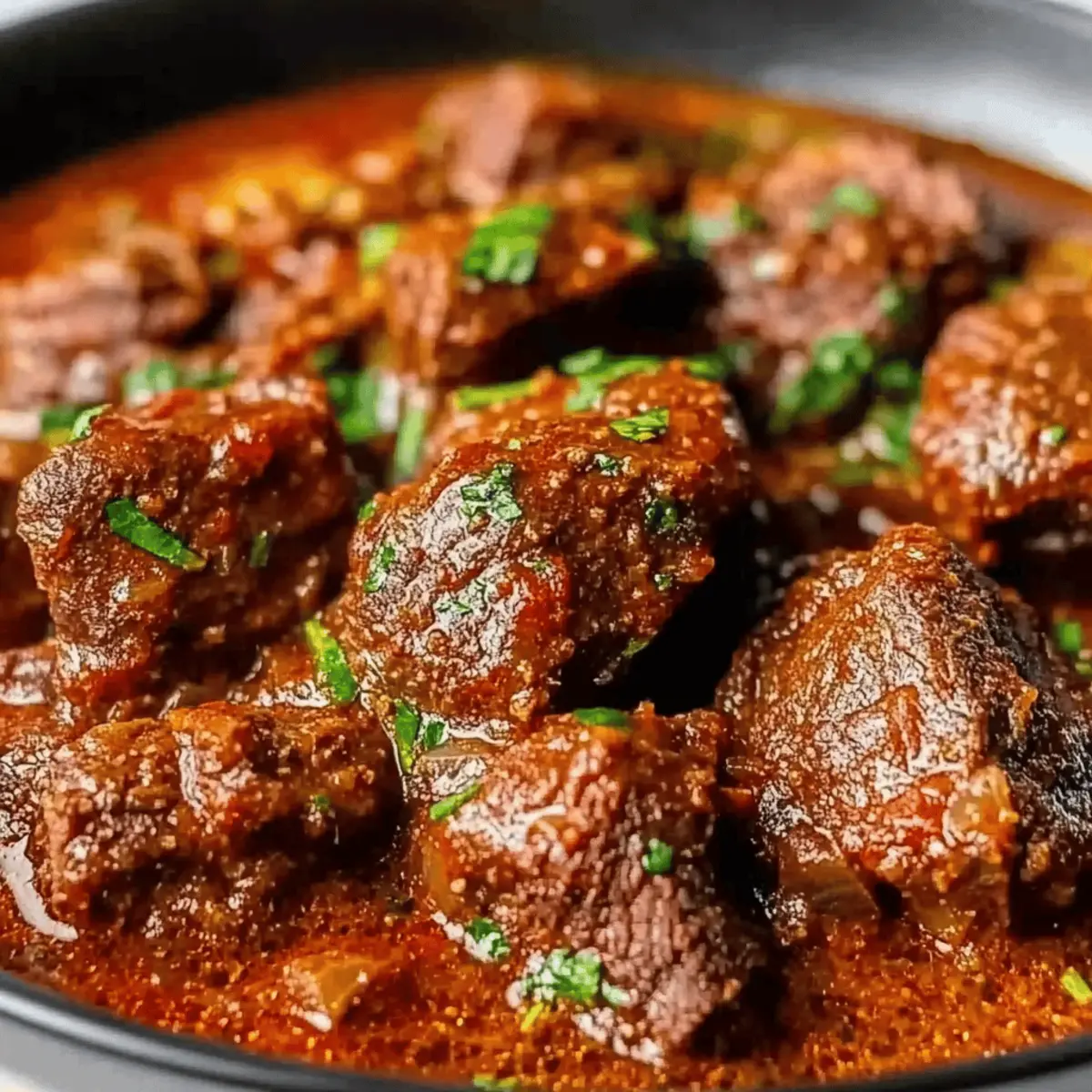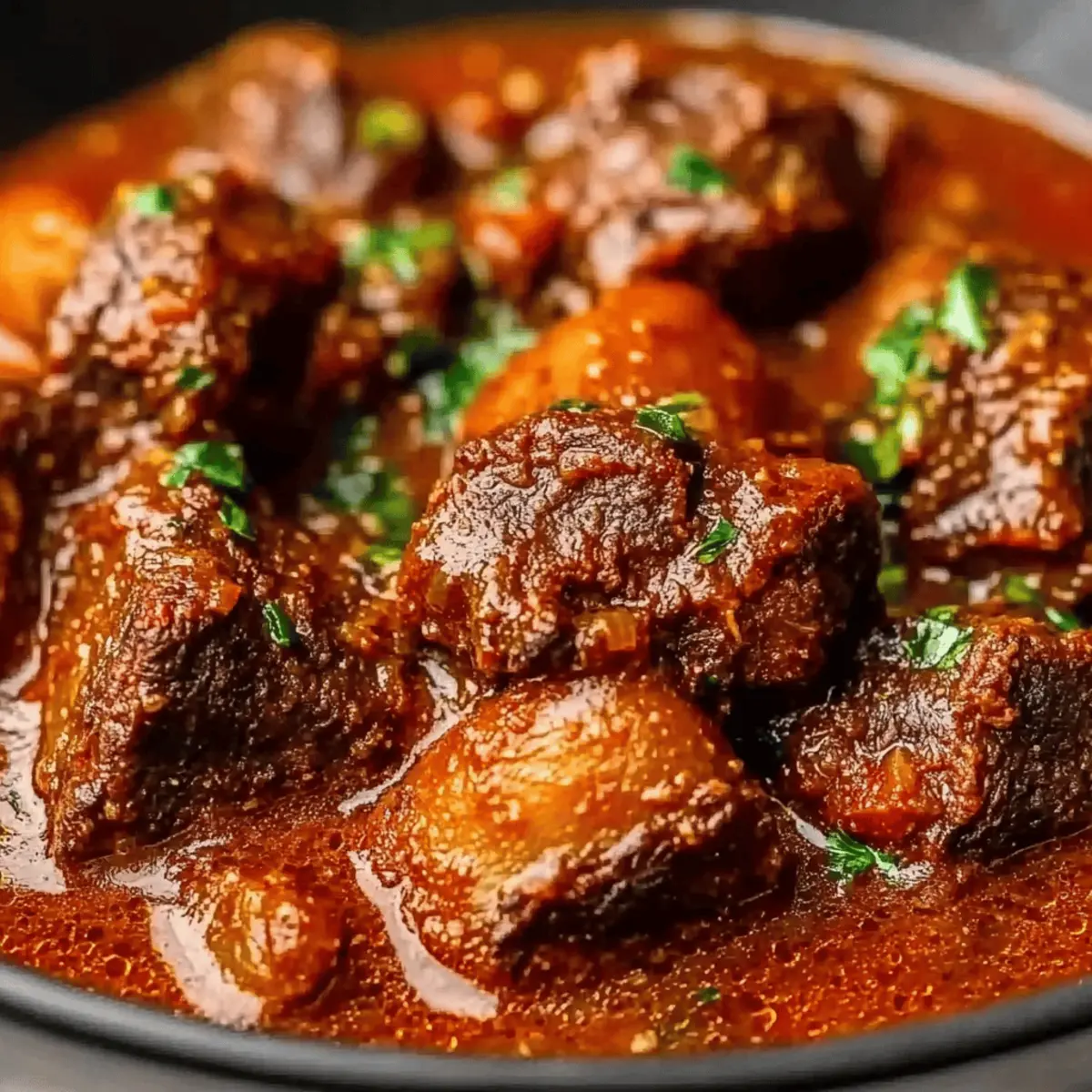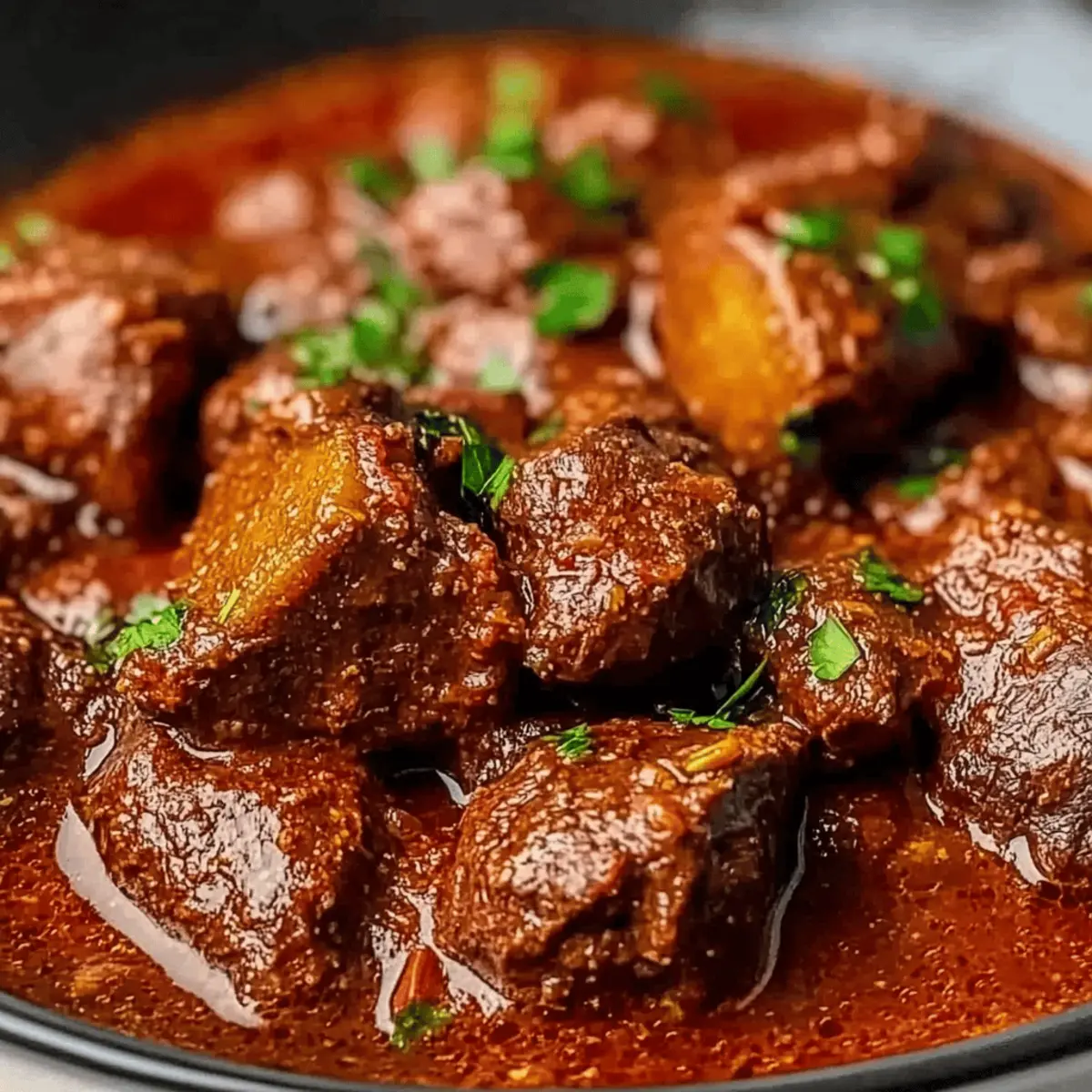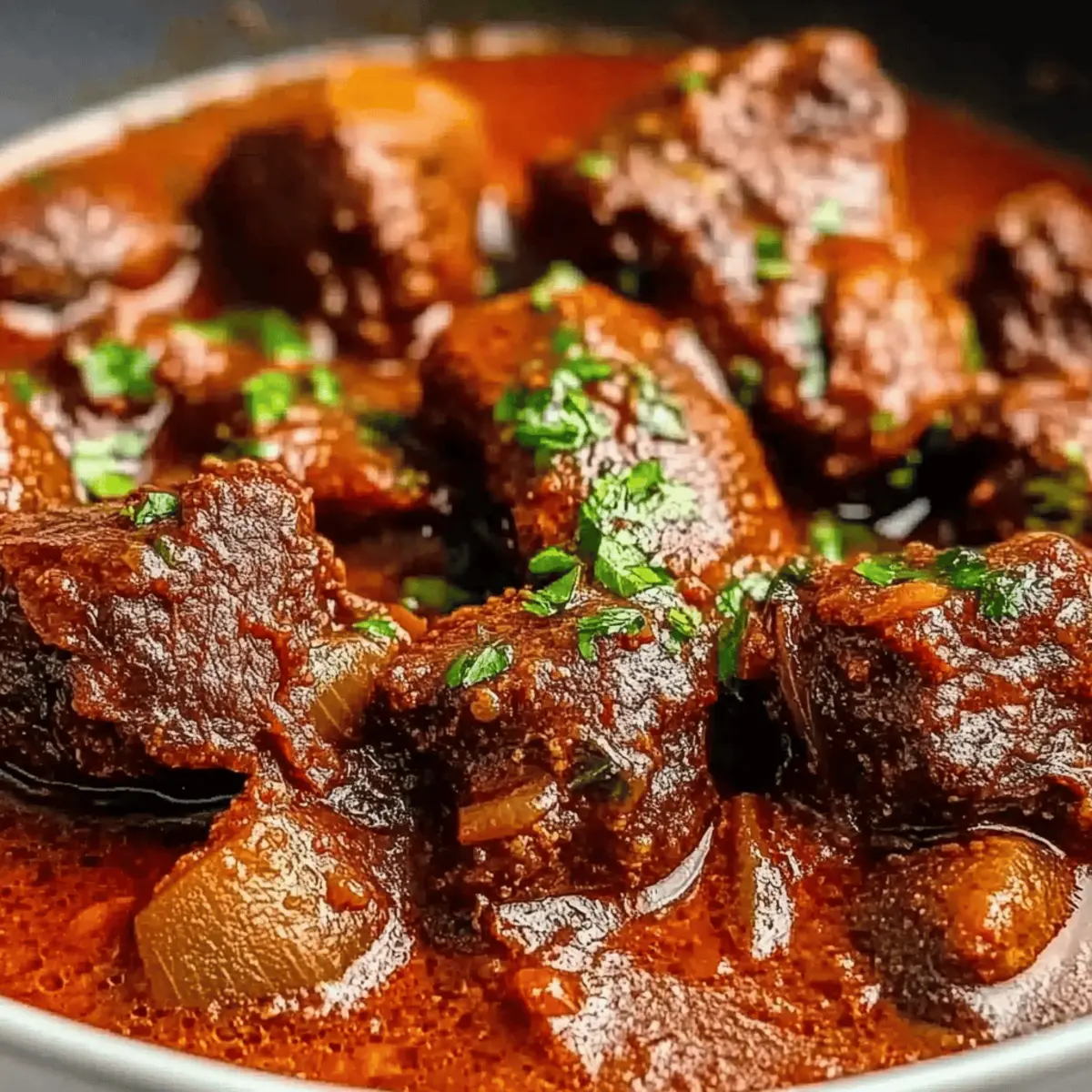As I stood in my kitchen, the aroma of sizzling onions hit me like a warm, inviting hug. This wasn’t just any meal; I was about to whip up a pot of Viral Nigerian Beef Stew, a beloved West African classic bursting with rich flavors and vibrant colors. This savory stew, known for its fiery kick and slathered in a deep red sauce, brings a comforting warmth that wraps around you, making it a perfect choice for a relaxing dinner or an exciting weekend feast. With its quick prep time and adaptability for various tastes, this dish is bound to impress. Whether you’re serving it over fluffy rice, yams, or crunchy fried plantains, your loved ones will likely ask for seconds—and even thirds! Curious about the secret to this unforgettable culinary experience? Let’s get cooking!

What Makes This Beef Stew Irresistible?
Savory Explosion: The robust blend of spices brings unparalleled richness and depth to every bite.
Versatile Cooking: Easily switch proteins or adjust spice levels, catering to all taste preferences and dietary needs.
Meal Prep Friendly: This stew tastes even better the next day, making it perfect for reheating or batch cooking. Pair it with Healthy Beef Broccoli to enjoy nutritious leftovers throughout the week!
Fan-Favorite: It’s an instant crowd-pleaser, whether for cozy family dinners or lively gatherings.
Cultural Flavor: Experience West African cuisine right in your kitchen, creating a memorable meal that sparks joy and connection.
Viral Nigerian Beef Stew Ingredients
For the Stew Base
- Beef – Tender cuts like stewing beef or beef chuck deliver the best texture; bone-in adds rich flavor.
- Onion – Sweetens the stew and layers depth to the overall flavor.
- Vegetable Oil – Essential for frying the sauce and developing that authentic taste; traditional recipes use a generous amount.
For the Sauce
- Scotch Bonnet Peppers – These fiery peppers provide signature heat and flavor; consider milder chilies as a substitute for less spice.
- Roma Tomatoes – Blend fresh tomatoes for depth and ensure to cook down to concentrate the flavor and reduce excess water.
For Flavor
- Chicken or Beef Broth – Enhances richness; choose gluten-free broth if the diet requires it.
- Seasonings (Salt, Spices) – Essential for enhancing overall taste; feel free to adjust according to your preference.
This Viral Nigerian Beef Stew is not just about nourishing the body; it’s about creating cherished memories in the kitchen. Enjoy your cooking adventure!
Step‑by‑Step Instructions for Viral Nigerian Beef Stew
Step 1: Prepare Base
In a large pot, heat 3 tablespoons of vegetable oil over medium heat until shimmering. Add 1 finely chopped onion, stirring frequently, and sauté for about 5–7 minutes until the onion is golden and fragrant. This step builds the rich foundation of flavors, making your Viral Nigerian Beef Stew truly special.
Step 2: Blend and Cook Sauce
While the onions cook, blend 4 fresh Roma tomatoes and 2–3 Scotch Bonnet peppers in a food processor until smooth. Carefully pour this mixture into the pot with the onions, stirring well to combine. Allow the mixture to fry on medium heat for about 10–15 minutes, stirring occasionally, until it thickens and the oil begins to separate from the sauce, intensifying the stew’s vibrant flavor.
Step 3: Brown the Beef
Add 2 pounds of tender beef, cut into chunks, to the pot. Sear the beef pieces on medium-high heat for about 5–7 minutes until they are well-browned on all sides. This step enhances the meat’s flavor and helps lock in the juices, resulting in a delicious and hearty Viral Nigerian Beef Stew.
Step 4: Simmer
Pour in 4 cups of chicken or beef broth, ensuring the beef is submerged. Bring the stew to a gentle boil, then reduce the heat to low. Cover the pot and let it simmer for about 45 minutes, stirring occasionally, until the beef is tender and the flavors meld beautifully. The aromatic essence will fill your kitchen, promising a delightful meal ahead.
Step 5: Adjust and Serve
After simmering, taste the stew and adjust seasoning with salt and pepper as desired. If you’d like more heat, add additional pepper to suit your taste. Once everything is perfectly seasoned, serve your Viral Nigerian Beef Stew hot over steamed white rice, yams, or alongside fried plantains for a complete and mouth-watering meal experience.

What to Serve with Viral Nigerian Beef Stew
Savor the culinary journey of rich flavors and satisfying textures with delightful accompaniments to enhance your meal.
-
Fluffy White Rice: A classic choice that soaks up the spicy sauce, enhancing each delicious bite.
-
Boiled Yams: Creamy and hearty, yams provide a delightful contrast to the stew’s vibrant flavors and texture.
-
Fried Plantains: These sweet, caramelized bites add a touch of sweetness which balances the stew’s fiery heat beautifully. Pairing fried plantains creates a wonderful harmony of flavors.
-
Garlic Bread: Crusty and aromatic, perfect for scooping up the savory stew and making every meal more enjoyable.
-
Coleslaw: A crunchy, fresh side, coleslaw adds a cool contrast that refreshes the palate between bites.
-
Nigerian Jollof Rice: To elevate the experience, serve with this iconic dish, creating a fusion of rich and spicy flavors that celebrates West African cuisine.
-
Chilled Palm Wine: For a cultural touch, this mildly sweet drink beautifully complements the spiciness of the beef stew, enhancing the overall experience.
-
Coconut Rice: Lightly sweet with hints of coconut, this chewy rice option contrasts the stew’s spiciness while providing a unique flavor profile.
Expert Tips for Viral Nigerian Beef Stew
Fry for Flavor: Do not skip frying the sauce thoroughly; this intense cooking step creates the rich, bold flavor that defines the stews.
Oil Adjustment: While traditional recipes use plenty of oil for richness, you can reduce it for a lighter version without sacrificing flavor.
Flavor Enhancement: Stews taste remarkable the next day; make extra for perfect leftovers that are easy to reheat and enjoy!
Spice Control: Adjust the number of Scotch Bonnet peppers to cater to your spice preference and avoid being overwhelmed by the heat.
Meat Substitutes: Consider experimenting with different proteins like chicken or lamb to make the Viral Nigerian Beef Stew fit your family’s tastes.
Variations & Substitutions for Viral Nigerian Beef Stew
Feel free to explore different twists and substitutions to make this stew your own while enjoying its rich flavors!
-
Protein Swap: Use chicken or lamb instead of beef for a lighter, yet equally delicious variation. Each meat brings its unique flavor to the dish!
-
Creamy Version: Stir in a splash of coconut milk during the simmering phase for a rich, velvety sauce that adds a tropical twist to the stew.
-
Vegetable Boost: Add chopped carrots, bell peppers, or spinach to the stew for an extra burst of color and nutrition—everyone loves a good veggie!
-
Flavorful Broth: Experiment with homemade broth from Stovetop Ground Beef instead of store-bought for deeper flavor.
-
Low-Carb Option: Serve the stew with cauliflower rice instead of traditional rice or yams for a nutrition-packed, lower-carb alternative that doesn’t skimp on taste.
-
Herb Aroma: Toss in fresh herbs like thyme or cilantro for added depth of flavor. These fragrant herbs elevate the dish, making it feel even more special!
-
Spice Levels: Adjust the heat by using less Scotch Bonnet pepper or add a touch of sweetness with a teaspoon of sugar to balance the heat. Customize it just the way your taste buds like!
-
Flavor Infusion: Include a splash of soy sauce or Worcestershire sauce to introduce a savory umami depth that complements the spiciness beautifully.
No matter how you choose to customize it, each variation brings its own delightful flair to your Viral Nigerian Beef Stew experience! Enjoy creating your own version of this beloved dish.
Make Ahead Options
These Viral Nigerian Beef Stew preparations are a lifesaver for busy home cooks looking to save time! You can chop the beef and marinate it with seasonings up to 24 hours in advance, allowing the flavors to penetrate the meat deeply. Additionally, the sauce can be prepared and refrigerated for up to 3 days; just ensure it’s cooled completely before storing in an airtight container to maintain quality. When ready to cook, simply reheat the sauce in a pot, add the marinated beef, and simmer until tender (approximately 45 minutes). This method ensures your stew remains just as delicious, providing comforting and flavorful meals with minimal effort on hectic days!
How to Store and Freeze Viral Nigerian Beef Stew
Fridge: Store the stew in an airtight container for up to 5 days, ensuring it cools completely before refrigerating to maintain freshness.
Freezer: Freeze your Viral Nigerian Beef Stew for up to 3 months in a freezer-safe container. For best results, double-wrap it in plastic wrap before sealing.
Reheating: When ready to enjoy, thaw overnight in the fridge and reheat gently on the stove over low heat, adding a splash of water or broth if it thickens too much.
Meal Prep: This stew often tastes even better the next day, making it perfect for meal prep and batch cooking!

Viral Nigerian Beef Stew Recipe FAQs
How do I choose ripe tomatoes for the stew?
Absolutely! When selecting Roma tomatoes, look for ones that are firm but slightly yielding to pressure, with a deep red color. Avoid any with dark spots or blemishes, as these may indicate overripeness. Fresh tomatoes will provide the freshest flavor, contributing to the overall richness of your Viral Nigerian Beef Stew.
Advertisement
How should I store leftover stew?
You can store your stew in an airtight container in the refrigerator for up to 5 days. Ensure the stew cools completely before sealing it to maintain its freshness and flavor. When reheating, gently warm it on the stove over low heat, and consider adding a splash of water or broth if it thickens too much.
Can I freeze the Viral Nigerian Beef Stew?
Very much so! To freeze your stew, place it in a freezer-safe container and ensure it’s double-wrapped in plastic wrap to prevent freezer burn. It will keep well for up to 3 months. When you’re ready to enjoy it, thaw it in the refrigerator overnight and gently reheat on the stove until heated through.
What can I do if my stew is too spicy?
If you find that your stew has turned out spicier than you intended, don’t worry! There are a couple of easy fixes. You can add a splash of coconut milk or a spoonful of sugar to balance the heat. Another option is to incorporate more broth or diced tomatoes into the stew to dilute the spice while adding flavor.
Are there any dietary considerations for this recipe?
Absolutely! For those with gluten sensitivities, be sure to use gluten-free broth and check the labels of any spices you use. Additionally, if cooking for your pets, avoid any ingredients like Scotch Bonnet peppers and onions, as they can be harmful to dogs and cats.
How do I know if the beef is cooked properly?
To ensure your beef is tender, it should be simmered until you can easily shred it with a fork. When you first add the beef, give it at least 45 minutes of simmering time. If it’s not quite fork-tender after that duration, cover and let it simmer longer, checking for tenderness every 10 minutes until it reaches the desired texture.

Savory Viral Nigerian Beef Stew That'll Ignite Your Taste Buds
Ingredients
Equipment
Method
- In a large pot, heat 3 tablespoons of vegetable oil over medium heat until shimmering. Add 1 finely chopped onion, stirring frequently, and sauté for about 5–7 minutes until the onion is golden and fragrant.
- While the onions cook, blend 4 fresh Roma tomatoes and 2–3 Scotch Bonnet peppers in a food processor until smooth. Pour this mixture into the pot with the onions, stirring well. Allow frying on medium heat for about 10–15 minutes until it thickens.
- Add 2 pounds of tender beef to the pot. Sear the beef on medium-high for about 5–7 minutes until browned.
- Pour in 4 cups of broth, ensuring the beef is submerged. Bring to a gentle boil, reduce heat to low, cover, and let simmer for about 45 minutes.
- After simmering, taste and adjust seasoning with salt and pepper as desired. Serve hot over rice, yams, or alongside plantains.





